Last month I drove to the amazing Royal Range in Nashville to take Rangemaster’s Defensive Shotgun Instructor class. I had previously taken all three levels of the Rangemaster handgun instructor classes and the one-day shotgun user class. It was time to get the shotgun instructor cert.

I was a little worried. The class was only 16 days following my prostate cancer surgery and I was still under instructions not to do anything physical and not to lift more than 10 pounds. I’m not real good about following orders and my shotgun didn’t weigh even close to 10 pounds. I proceeded against medical advice.
I’m happy to report that although I was quite a bit more fatigued than usual, I passed the course. I ended up with 100% scores on both the written and shooting tests and a third place overall in the class based on the shotgun Casino Drill. I’ll take it. Here are some things that stood out about the class…
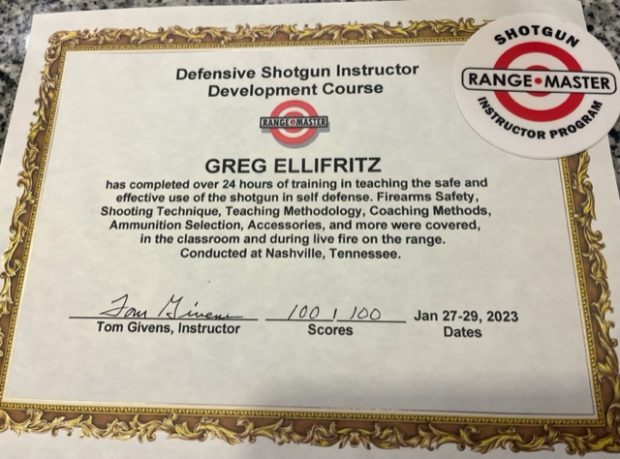
The Guns
I expected a wide variety of guns in a class of 20 students. I was wrong. About half the class was using Beretta 1301s. The other half of class was using Remington 870s. That’s a clue.
There was one outlier. One guy brought a Mossberg 930. Tom predicted that the gun would not survive the class and he was correct. On the final day the shell lifter actually warped and twisted making it impossible to load rounds into the magazine. The student finished the class using my Beretta 1301.
My Beretta 1301 performed great. I was using super light Winchester AA trap loads so I didn’t get as beat up after my surgery. I had one malfunction (fail to eject) with the trap loads. I didn’t have any issues with the buckshot and slugs I fired. Overall I shot 348 total rounds in the class with just that single mechanical malfunction.
My Beretta did have a couple more user-induced malfunctions as well. Here is video of my screwed up emergency port reload in a man on man shooting competition. Even simple stress often negatively affects performance.
Ammo
There were lots of quality control problems with the ammo. Take a look at the crimp on the shell below. I saw at least two other shells that looked just like that one over the weekend. I also saw one shell with an extra piece of plastic attached near the shell rim, preventing it from being loaded into the magazine. The demand for ammo is so great that quality control is slipping with every ammunition manufacturer. Be especially vigilant evaluating your defensive ammunition.
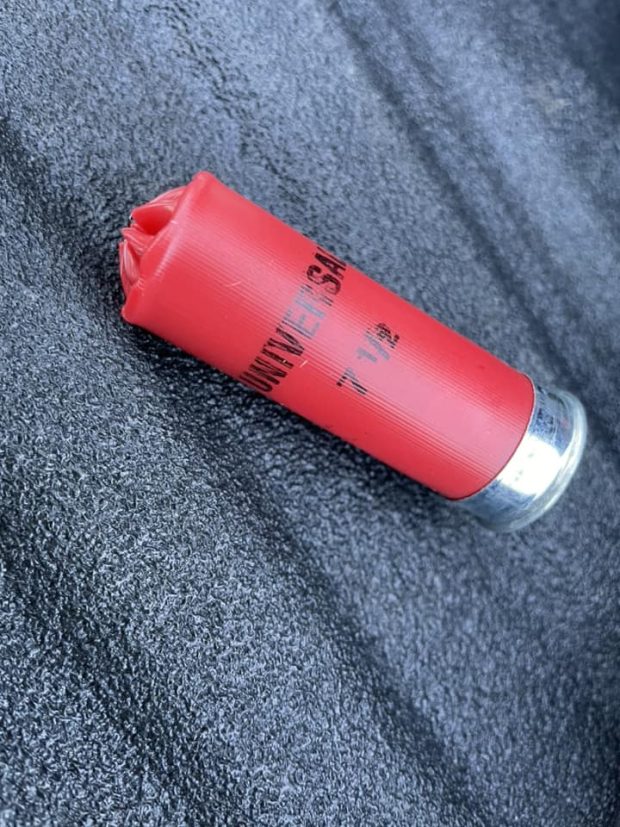
Image courtesy of TDI’s John Motil
Patterning
There was a wide variety of patterns thrown between different shotgun barrels an ammo. As expected, the Federal Flight Control eight pellet 00 Buck loads performed the best.
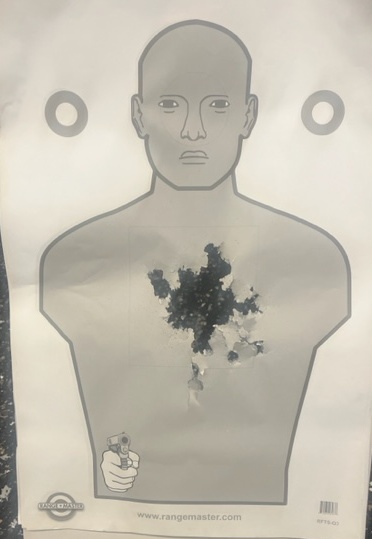
Five yard birdshot drill patterns
There were two big surprises for me. Both were identified by my friend and fellow instructor Jonathan Willis, who teaches for GunSet Training. Take a look at the five and seven yard patterns for the Federal X2 “personal defense” loads that are essentially copper plated fishing sinkers. This is a five yard headshot and some seven-yard bodyshots. Frightening. No one should ever buy this ammo for serious purposes.
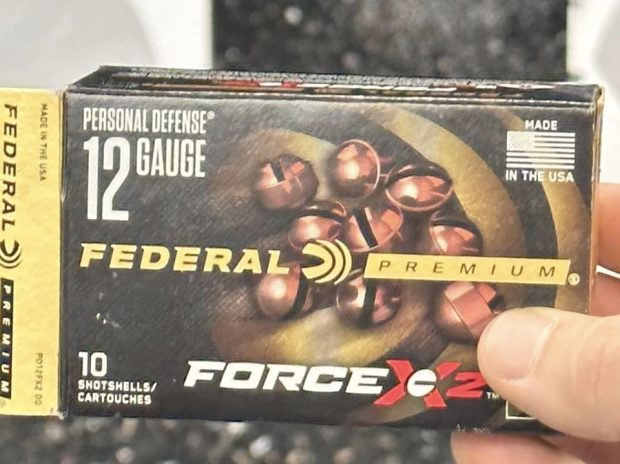
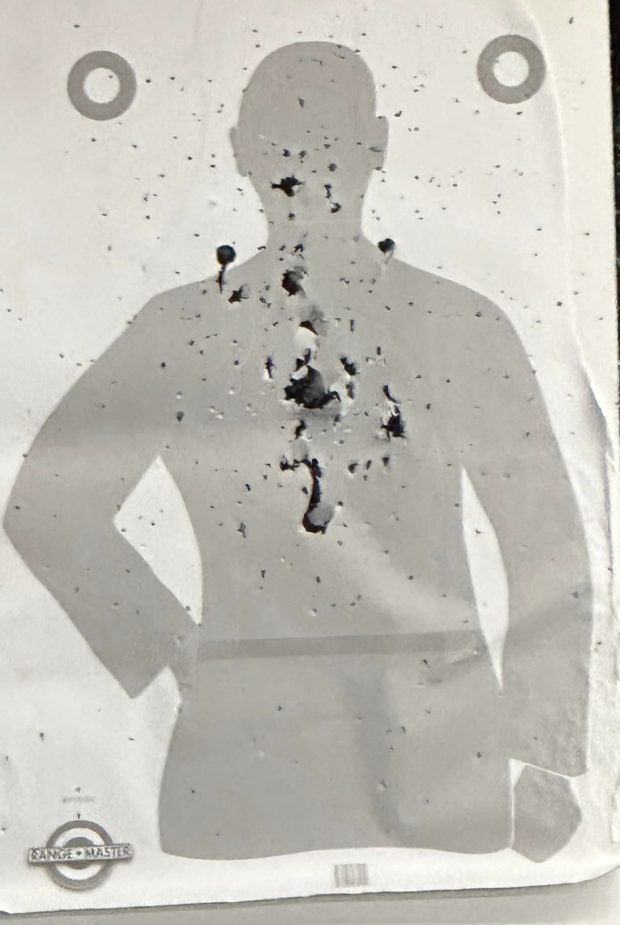
Another shock was the Remington 00 Buck “law enforcement” loads fired in the photo below. Most quality buckshot loads make a one-hole pattern at five yards. This pattern is way too big and those flyers out of the head area are disturbing. That round is wholly unsuited for both law enforcement or self protection.

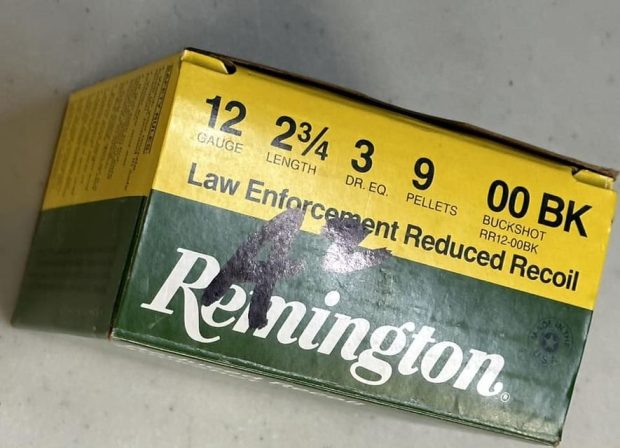
Please pattern your chosen defensive loads out of your shotgun before relying on them for home defense.
Accessories
Tom Givens isn’t a big fan of shotguns with lights or slings for home defense. I only saw a couple lights and my shotgun was the only one with a sling. Tom demanded that we reload from ammo on the gun as we wouldn’t likely be carrying bandoleers or dump pouches in our gunfights. Most of us used side saddle type shell cards or the carrier from Aridus industries. I didn’t note any obvious issues with any of the shell storage devices.
Red Dots and sights
About half the class was running some type of red dot. Most were Holosuns, but I saw a couple of Aimpoints. One of the Holosuns shut off during firing one time, but turned back on at the push of a button and didn’t have any additional problems the rest of the class. None of the red dots fell off or lost power during the class.
According to Tom, this was an unusual class. In most of his shotgun instructor classes he sees a failure rate of up to 50% with red dots mounted on shotguns.
The screws on the rear sight on my Beretta 1301 (and those of two other students in class) loosened over repeat firing. I had to tighten the screws about three times a day to keep the sight from falling off. I would have applied thread locker, but I’m going to replace the unit with an Aridus Crom mount and an Aimpoint red dot soon. If you have a Beretta, check those rear sight screws.
Long stocks
Students who had long factory stocks had more problems controlling recoil than students with shorter stocks. Tom warned everyone in an email before class to replace their stocks. Some folks didn’t and their performance suffered a bit.
Most people do best with a stock that is 12″-13″ long. The length of pull for most factory stocks is over 14.” Tom says that the most useful shotgun modification anyone can make is to shorten the length of pull. Doing so creates less fatigue and allows the student to get hips and shoulders more square to the target to put more body weight behind the gun. Shorter stocks mean faster shots from the ready position as well as better recoil control.
Tom also suggested covering the bottom portion of the shotgun recoil pad with some slick electrical tape. When shouldering the gun from a high ready position, sometimes the tacky rubber recoil pad snags your clothing and interferes with your presentation. Putting some smooth tape over the back of the recoil pad where it snags will allow the user to quickly slide the shotgun into proper position without interference with the shooter’s clothing. I will definitely be adding this modification to all my future defensive shotguns.

John Motil showing the difference between a 14″ factory length of pull and a 12.25″ length of pull aftermarket stock.
Conclusion
If you want to learn how to properly run a combat shotgun, Tom’s classes are top notch and I highly recommend them. He travels all over the country and teaches several shotgun instructor classes every year. They always fill up. If you are interested in taking the class, find one and register as soon as possible. You won’t be disappointed.
FTC disclosure- I paid full retail price for the class. I also paid for my own travel expenses and ammunition. I am not being compensated in any way from Tom Givens or Rangemaster for writing this review.










